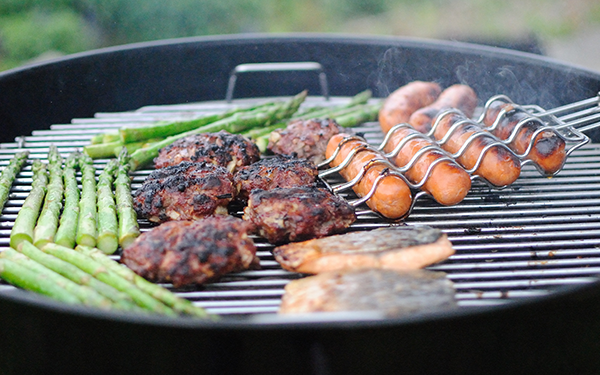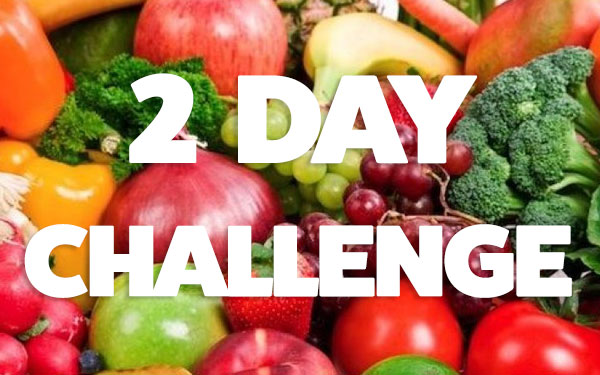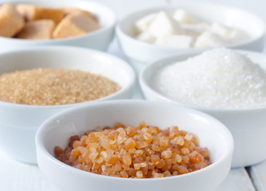Getting Started
So you’re ready to make one of the most important decisions of your life: to change the way you look at food and to change your eating habits. For many people who have successfully lost weight, the moment they knew they could do it was the moment when something just “clicked”. For me, something clicked 19 years ago when I realized I could lose weight and change my life by living a low-carb lifestyle. Low-carb was talking my language when it suggested I could get healthy by simply enjoying all the wonderful fresh food that as a chef I had been preparing for others my whole life. While I skipped meals and ate high-carb junk foods on the go, I was pleasing others with my culinary creations.
Today I’m down 265 pounds, and my family of four has lost over 550 pounds collectively and we have kept it off. So I’ll tell anyone who will listen exactly how we did it, and spread the word that low carb is really all about fresh foods!
Carb Proofing Your Pantry
Okay, so you’re fired up, armed with at least a basic understanding of the low-carb regimen, and ready to get started on your new lifestyle. If you’re like most people, you need to make quick and easy meals using simple and inexpensive fresh ingredients that you can find in your local grocery store (lucky for us that low–carb is not about processed foods, because processed will always cost more and give you less). Shopping and filling your kitchen with all the great low-carb foods that will keep every meal exciting and interesting is key to successful low-carb living.Before you start shopping, you need to carb-proof your pantry to make room for all those wonderful low-carb fresh foods you’ll be buying. It’s simple – just pack up all those foods that are high in carbs and low in nutritional value, starting with the white stuff: sugar, flour, pasta, and rice. Put them in a box and drop them off at your local food bank. (if others in your house are not on a low-carb diet, simply separate the foods and assign a low-carb cabinet that’s just for you.)
Reading Food Labels
Next, you need to learn how to read food labels and get rid of anything that has added sugars. A low-carb diet allows natural sugars, such as those found in canned tomatoes, in moderation, but you don’t have to put up with products that conceal additional sugars, such as corn syrup solids or high-fructose corn syrup. You can find these added or hidden sugars by paying attention not only to the sugars or carbohydrates listed on nutritional labels, but also to the added sugars and starches in the ingredients list. When you get started reading labels, you will be surprised to find out where all that sugar has been hiding – in condiments, salad dressings, deli meats, and even canned veggies. Once you have the chips, candy, and white bread packed up and moved out, your pantry may be looking rather empty. Don’t despair – there are fresh low-carb alternatives and replacements for almost all those high-carb processed foods. Your pantry will only contain a few staples, and your refrigerator will be overflowing with all the good fresh stuff – and that’s the way it should be!
Grocery Shopping
Shop The Outer Isles First!
Stick with the outer aisles of the grocery store, as that is where you will find all the fresh, healthy, and naturally low-carb foods that have always been there. I love vegetables, and it seems my shopping cart always homes in first on the produce aisle. I just don’t think we hear enough about veggies on low-carb diets, especially since about 98 percent of all vegetables are naturally low in carbohydrates.
Ones to avoid, at least in the beginning, are carrots, corn, white potatoes, and peas. And you may wish to avoid certain beans and legumes, such as lima beans or navy beans, at first; you may be able to add some of them back to your diet as you approach your desired weight. When you’re starting out on a low-carb diet, you should use vegetables that have natural sugars, such as onions and tomatoes, in moderation. And if you are limiting your carbs to 20 or 30 grams a day, you can’t go wrong with lettuces, which have just a couple carbs for a couple cups. I love those bags of prewashed salad mixes, which offer great convenience and which you’ll often find on a two-for-one sale.
Some of the lowest-carb vegetables that we use almost daily are celery, cucumbers, zucchini, yellow squash, cauliflower, broccoli, green beans, bell peppers, spinach, eggplant, and my favorite, mushrooms. The list also includes cabbages, spaghetti squash (great as an alternative to pasta), pumpkin, asparagus, snow peas, all fresh herbs, garlic, scallions, and more.
Navigating The Produce Isle
In the produce department you can find freshly made salad dressings (read the labels to check for added sugars). It’s also sometimes the best place to find bargains on bulk packages of natural nuts such as pecan and walnut halves, whole almonds, and sunflower and pumpkin seeds. (Always buy raw or plain nuts, as the dry-roasted snack varieties cost much more and are coated with starches.) If your store has a salad bar, that’s a great way to save time after a busy day – just buy precut veggies and fruits that are ready to go. If you are cooking for only one or two, you can actually save money, especially on items for stir-fry dishes, by buying only what you will use for that meal. As for fruits, you definitely need to avoid high-sugar culprits such as watermelon, grapes and oranges, and bananas. You can add back in other fruits such as Apples, pears, peaches, and plums as you get close to your desired weight, although you should avoid them at first.
You can’t go wrong with the lowest-carb fruits, which my family enjoys all the time – all berries, cantaloupe and honeydew. Strawberries are the best choice at about 1 gram carb each; next come raspberries. Blackberries, and blueberries, all loaded with antioxidants. Lemons and limes used sparingly in cooking are totally acceptable.
Hit The Deli Count
From the produce isle, I continue on to the deli counter, where I usually pick up a rotisserie chicken for a quick dinner or lunch. You can’t go wrong with sliced deli ham, turkey breast, thick sliced bacon without nitrates, Italian dried meats and sausages such as prosciutto or capicola, and salami, pepperoni and Mortadella are all great! Better brands are usually your best bet for the lowest carb deli meats, but you must ask to check the labels. They should read 0 or 1 gram carb per serving at most to be acceptable. And unless the store makes it’s own and lists the ingredients, I avoid premade salads such as chicken or tuna, as most are processed with sugars and starches. This is also where you can order some of this and some of that and put together a Last-Minute Antipasto Platter for an impromptu party get-together.
Fresh Seafood
In the fresh seafood department, I usually buy whatever looks so fresh it jumps out at me. Pretty much everything is a great low-carb catch in this department, from salmon (preferably wild) to shrimp, lobster, scallops, mussels, and clams, to any fish fillet.
Fresh Meats and Poultry
In the meat department, I look for sales and family packs to save money and usually pick what can go on the grill and be ready in minutes. We all know about hamburgers and hot dogs (make sure they are all-beef and 0 gram carb), but you can also opt for boned skinned chicken breasts and London broil. And then there are those 10-pound bags of chicken leg quarters. I use the legs to make chicken salad and soup, and then I bone the thighs for marinating and grilling. You can buy boneless pork loins in whole large pieces for a fraction of their usual cost when sold cut, and then use them for several different meals – say, center-cut pork chops, roasts, or stir-fry dishes. Make a simple baked ham or beef roast for dinner. Then use the leftovers for lunches at a fraction of the cost of sliced deli meats. The sky is the limit in the meat department, so widen your horizons and enjoy Italian and lean turkey sausage, turkey cutlets, veal and lamb steaks and chops, Cornish game hens, pork and beef tenderloin, and so on.
Rules For the Dairy Isle
Now it’s on to the dairy department, where the main rules are to avoid milk, read all labels carefully for added sugars, and usually buy whole-fat products. (If you do decide to limit your fats by purchasing lower-fat dairy products, check carefully for sugars, usually added to replace the lost flavor and body of the removed fat.) We all know eggs are in and cheeses for the most part are 0 carb; just make sure to buy real cheese such as deluxe American slices, and not processed “cheese food.” I also pick up staples such as sour cream and half-and-half and heavy cream for baking and cream cheese and ricotta cheese, which are great for making simple snacks.
Frozen Foods
Moving on to the frozen food section, you will find some great time saving options: inexpensive bags of spinach, broccoli, or cauliflower, which offer easy fixings for dishes such as cauliflower mashed “potatoes,” and frozen berries, which can stand in when the fresh ones aren’t available.
And lastly, once you have shopped the outer aisles for all your fresh foods, you will need to shop carefully for low-carb pantry and baking items, making sure to read labels for carbs and added sugars.
(I have included a basic Low-Carb Pantry List below!)
As a chef, this long listing of fabulous healthy foods is exactly what made it all “CLICK” for me. I hope it does the same for you as you shop with a wider view of what naturally low-carb foods truly are available to everyone; fresh foods that have ALWAYS been there and aren’t going anywhere!
Keep On Low-Carbin’!
George Stella
For tons more low carb recipes, ideas, and support please visit:
www.StellaStyle.com
www.facebook.com/LowCarbingAmongFriends
Pantry List
Here is a basic list of what I keep in my pantry, most of which is found in the baking, condiments or canned foods isles of your grocery store. Be sure to check the labels for hidden added sugars though!
CONDIMENTS, BAKING :
- Almond extract, no sugar added Almond flour (available at health food stores)
- Almonds, raw (grind in a food processor to make your own almond flour)
- Anchovy paste
- Anchovies
- Artichoke hearts, marinated
- Baking powder
- Baking soda
- Bamboo shoots, canned
- Beef consommé
- Black soy beans, canned
- Butter
- Caesar salad dressing, no sugar added
- Chicken consommé
- Cocoa powder, unsweetened
- Cooking sprays, olive and vegetable
- Crystal light drink mixes, especially SUNRISE ORANGE flavor
- Dill pickle relish
- Flax meal
- Green chili peppers, canned
- Hearts of palm
- Jello, sugar-free, all varieties
- Liquid smoke
- Louisiana hot sauce
- Macadamia nuts
- Mayonnaise, heavy only
- Mushrooms, marinated
- Mustard, yellow and Dijon
- Natural peanut butter
- Olives, black, green pimento, stuffed, Greek, etc…
- Olive oil
- Pecan halves
- Pepperoncini
- Pickle spears, kosher dills, Claussen garlic
- Pork rinds
- Ranch dressing, no sugar added
- Roasted red peppers
- Salsa, no sugar added (natural is OK)
- Sesame oil
- Sesame seeds, black and white
- Soy flour
- Soy sauce
- Sugar free sweet pickle relish (Mt. Olive brand)
- Splenda, bulk pack and individual packets (our preference, choose what you like:)
- Sunflower seeds, shelled and roasted (NOT dry roasted)
- Teriyaki sauce, no more than two grams carbs per serving (all have some sugars)
- Tobasco sauce, including Chipotle variety
- Tomato paste, no sugar added
- Tomato sauce, no sugar added
- Tomatoes, whole and peeled, no sugar added
- Tuna, canned white in water
- Unflavored gelatin, Knorr brand
- Unsweetened coconut (or fresh)
- Unsweetened bakers chocolate
- Vanilla, no sugar added (usually the artificial has zero sugar)
- Vinegars, red wine, rice wine, balsamic, white
- Walnuts, shelled halves
- Table salt
- Kosher salt
- Black pepper, whole and coarse ground
- White pepper, ground
- Garlic powder
- Basil leaves
- Oregano leaves
- Poultry seasoning
- Bay leaves
- Thyme leaves, whole and ground
- Tarragon leaves
- Cayenne pepper
- Ground mustard
- Parsley flakes
- Paprika, Hungarian red
- Chili powder
- Ground cumin
- Onion powder
- Celery seed
- Rosemary leaves
- Beef base, no sugar
- Chicken base, no sugar
- Worcestershire sauce
- Old bay seasoning
- Canola oil
- Extra virgin olive oil
- Capers
- Allspice
- Cloves, whole and ground
- Pumpkin pie spice
- Crushed red pepper
- Nutmeg
- Cinnamon
- Ground Ginger






Leave A Comment
You must be logged in to post a comment.